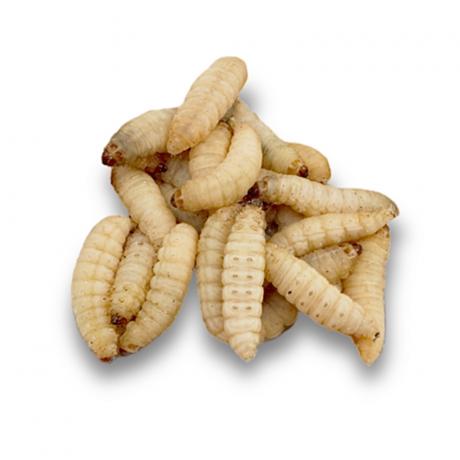

These are a rich food source, used as a treat for a wide variety of exotic pets. Perfect for feeding both in its larvae form and as adult moths if left to pupate. People often feed these to fish, poultry and birds, especially during the nesting season.
Wax Worms are also known as greater wax moths or honeycomb moths. They are a pale cream coloured, soft skinned caterpillar or larvae and they will reach a length of up to 25mm before beginning to darken and pupate inside a silk cocoon. They will emerge as adult moths after around 1-9 weeks depending upon temperatures. The adults are brown-grey and are up to 20mm in length. They tend to crawl and flutter for the first few days after hatching, living an average of 12 to 21 days.
This species is thought to have originated in Asia, but has spread throughout Europe (including Great Britain) Northern Africa, America and New Zealand and Australia. In spite of them making excellent food for reptiles and birds, they are in fact an invasive species which parasitises bee hives, feeding on the wax combs, pollen and honey.
Our Wax Worms are bred in a modern, ethical facility in the UK, reared on high end food - meaning that they arrive to you fresh and in excellent health as standard.
On arrival, your Wax Worms may appear immobile if temperatures are low but will soon become active when warm again. They will be delivered in specially ventilated pre-pack tubs containing wood shavings to keep the humidity levels low.
Wax Worms will pupate more slowly at lower temperatures and are best stored at temperatures between 12-20°C. If you would like to hatch them out into moths, keeping them warmer will accelerate this process. They can sometimes be stored in the fridge to slow down pupating, but please be aware, if temperatures are too low they can die off prematurely.
You will not need to feed the worms as they are towards the pupal stage of their development. They should last 1 - 4 weeks before they begin to pupate, depending on temperatures.
Wax Worms are soft skinned so easy to digest and naturally sweet and sugary due to their diet of honey and wheatgerm - this also makes them high in fat. This means that they should not form a staple diet for your pets, but make an excellent treat item. They are also ideal for providing a boost to underweight animals and also gravid or post lay females. They are naturally wriggly, meaning even the most stubborn of feeders will show interest in these fatty worms. If left to hatch, the moths provide nutrients for a number of species. Most reptiles seem to enjoy hunting these fluttering, slow moving moths from arboreal geckos, chameleons and mantids to bearded dragons and leopard geckos- species which eat a large number of flying insects in their natural habitat and chasing moths provides exercise and enrichment.
They are also readily enjoyed by many species of arachnids, mammals such as meerkats, fish, chickens and many species of wild birds. Wax Worms are also hugely popular with anglers as they can be used widely as fishing bait.
Wax Worms are best used as part of a varied diet, as with any livefood, variety is the key to providing a well balanced, nutritious diet. The addition of calcium and vitamins is recommended to further enhance the nutritional content of these worms.